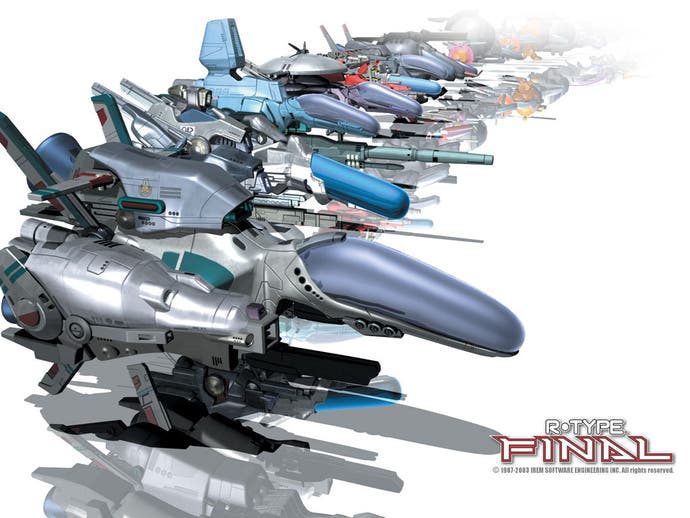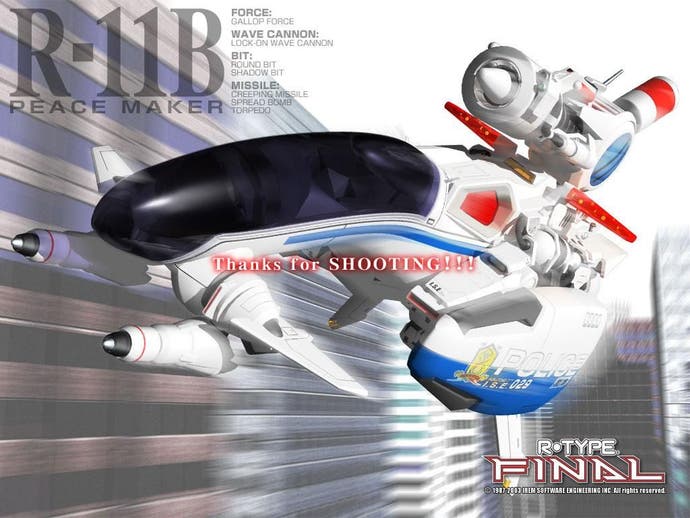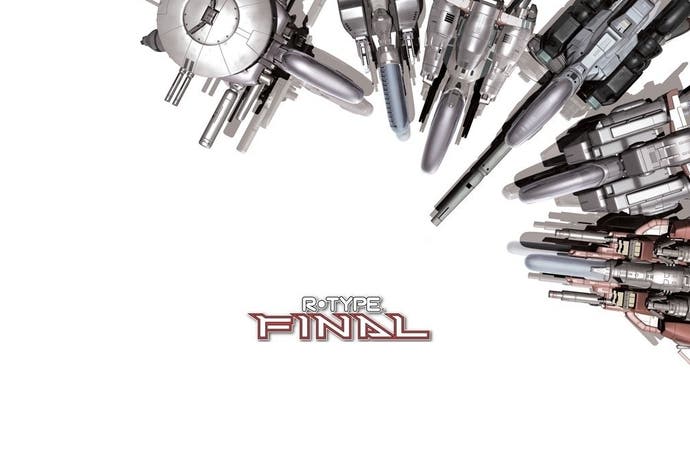R-Type Final retrospective
Good Bydo.
The R-Type series needs little introduction. From its stunning arcade debut in 1987, R-Type captured the hearts and minds of a generation by combining novel mechanics with a distinctive Giger-inspired biomechanical aesthetic. A grand sense of spectacle was matched by a challenge equally imposing, and although reliant on the learn-by-rote methodology that underpinned all shmups of the day, Irem's craftsmanship created a horizontal journey with a unique imagination. 26 years later, R-Type's Force and charge shot still feels like a genius twist on the genre's norms.
Bolstered by its uniqueness and wild success, the R-Type concept blossomed into a fine run of sequels. With the 1998 release of R-Type Delta, the series marked its first decade with a bravura entry that demonstrated precisely why true icons are timeless, proving that its template could sing in polygons just as well as it could in bitmaps. However, all good things must come to an end. In a unique and emotionally affecting turn, Irem decided to wave farewell to R-Type as a horizontal shooter in emphatic manner with 2004's R-Type Final.
Dissonant and confusing on release (thanks in part to a funereal pace, malicious checkpointing and some ponderous poetry introducing each stage), R-Type Final is a hugely poignant game in 2013. It was moving enough in 2004, but in hindsight its self-imposed finality carries a weird and unnerving emotional punch. Did head designer Kazuma Kujo sense something in the air, both in the Japanese games industry and at Irem itself? It certainly feels like it, for R-Type Final's sense of sadness and lament pervades the entire game. The title screen features the classic R-Type Force pod lying fins-up in a vast stretch of water, the sun setting in the distance. It's beautifully bleak.

Perhaps the saddest aspect of R-Type Final lies in its self-reference and self-celebration. There's joy mixed with sadness in this, and some signature bosses spring to mind. The third stage is a 3D take on the original R-Type's spectacular, stage-as-a-boss Warship level. It involves the unrelenting dismemberment of a huge battlecraft, with the player able to blow up skyscrapers in the process. Once mastered, it takes on a mournful mood. There's something of the whale hunt in it - it's not that tricky a level by any means, so it almost verges on cruelty as you're gently ushered around this giant, noble weapon to blast away its emplacements, engines and armour from every angle. Shooting it in the brain and enjoying a good 30 seconds of furious explosions doesn't carry the same sense of triumph that it did in the original R-Type. Here, it feels darker and more deliberate, something closer to an assassination.
Similarly clinical and mournful is the takedown of the original's xenomorph-aping Dobkeratops (who is in some ways more iconic than the series itself). Taking place after a tight, technical uphill march in an abandoned laboratory, Dobkeratops a patched-up specimen, kept alive in a giant tank as bacteria eats him from within. You dive in, shoot his head off and then slaughter his heart. As he finally dies, his decapitated body spasms wildly in its restraints. If the Warship was an assassination, this is euthanasia.
With the series' signature characters dispatched, R-Type Final divides by zero, jumps through the looking glass and starts getting really weird. The later stages of R-Type Final are so unexpected and so unusual they linger in your brain for years, the insanity mounting as you arrive at the Bydo Abyss. In the background, polygonal silhouettes of a man and woman meet, kiss and then appear to make love as your ship journeys through the stage. The background is also a liquid, and your ship creates ripples wherever you go. Again, I'm not sure what to make of that, but it's deep as hell. Then you're up against the series' ultimate boss - the Bydo core. I'm not going to spoil this fight, but watch it if you can't be bothered to play the game, and bear in mind this YouTube comment: "It felt as though IREM has put all their feelings in that final shot."
While R-Type Final's levels may be a slow-paced tour through decaying nostalgia (that turns into abstracted madness), they're not the best aspect of the game, nor are they where the celebration rings loudest. It's in the 101 ships. Of course, it's still the largest ship roster ever created for a shmup, making R-Type Final the Gran Turismo of its genre, and the variety of playstyles this depth of choice encourages is remarkable. Some of the ships are so obscure, they represent a new difficulty mode, such as Misty Lady, a ship that's surrounded by a cloud and fights with weather.

There are plenty of clever ideas; the R-9DH3 Concertmaster not only boasts the best gun model in the entire catalogue, but also rocks a multi-loop charge shot that plays a different note depending on the loop number. The amazingly named Sexy Dynamite II fires blobs of digestive enzymes for its wave cannon, which get longer the more loops you charge. The dizzying array of different Force types combine with the ships' wave cannons to make a catalogue of conceptual exploration within the R-Type formula that's exhaustive in scope - a dizzying celebration of the possibilities within the basic R-Type design.
Of course, it takes a fair while to tease those 101 ships from hiding, but it's here that we find the real triumph of R-Type Final. The last three ships are called Last Dancer, Curtain Call and Grand Finale. They're super-powered and only appear when the other 98 craft have been unlocked. However, in their naming lies R-Type Final's fabulous punchline: the whole game isn't just a shmup or a story or a history lesson. It's a performance.
Each of the game's stages are just that; stages awaiting a star so both can shine. In this context, R-Type Final's difficulty curve and multi-run aspects mean that each play-through is as much a rehearsal as it is an unlock grind. Those curious gaps in the action aren't just for charging up multi-loop cannons. They're spaces to dance or prepare, to play around or to reflect on the journey and, if you're inclined to intellectual noodling, to try and work out what the hell R-Type Final is trying to say. It's certainly trying to say something while it's prepping you for that one, glorious run in your favourite ship.
R-Type Final wants you to create an effortless pursuit of the Bydo menace through aspects of the series' history and then shoot beyond the moody sadness to engage in the concept of the 1 Credit Clear as a kind of performance art. In the greatest and most memorable game experiences, some indefinable magic happens in the interplay between designer, game and player to create something profound and impactful. It goes far beyond any vaunted attempt at art via narrative or characterization, and fuels those moments that stick in your memory long after you've forgotten why protagonist X had to shoot antagonist Y. That magic comes from the raw interaction of player and system, in the heat of the moment. In R-Type Final, it feels like there's a tangible attempt to consciously provide opportunities for this in its curious construction and its adagio pace, with 101 dancers to light up those dark and dying worlds in palettes of searing neon and glorious fluorescence.

There aren't many games that serve as deliberate farewell statements and I don't think there's a single game that says goodbye with such a profound combination of celebration and lament as R-Type Final. It turned out to be very final indeed, with Irem recently contracting into a mere kernel of its former self, a downward spiral that was somewhat presaged by R-Type undergoing a mishandled rebirth as a (conceptually exciting but executionally-flawed) turn-based strategy game with the R-Type Tactics titles on PSP. With both resulting in poor sales, it seems that R-Type as an ongoing lineage (even if not an ongoing shmup) was dead.
Kazuma Kujo left Irem in 2011 to form Granzella, which is currently producing content for PlayStation Home. This is a follow-on from the Japan/China only Home space for R-Type Tactics 2. That space, which was initially a promotional tool, hosted three life-sized R-Type ship models, one of which allows access to a mini-game that's less a promo gimmick and more a signpost of where the series may have been headed in Kujo's mind, despite the emphatic finality expressed in the game (and the manual, which carries a delightfully sentimental statement from the developers).
Of course, R-Type Final suffered the same fate as Kujo's other fantastically inventive game series Disaster Report. We're lucky that R-Type Final had the chance to create its own ending, as Disaster Report never got that luxury, being one of the casualties in Irem's self-immolating withdrawal from global core gaming. Knowing what happened to Irem, R-Type Final takes on a deeper sadness of its own. It serves as some unheeded warning beacon that when revisited, makes more sense and carries a different emotional weight thanks to hindsight. It deserves to sit alongside the likes of Ikaruga and Radiant Silvergun as a genre title that should command respect far beyond its niche fanbase, as it elevates what a mere shooter can actually be with a unique individuality. Irem ardently defines and demonstrates its own amazing grace, even as it plays out its own death.

